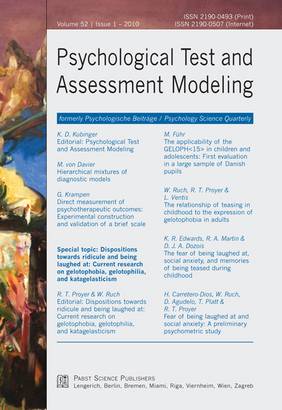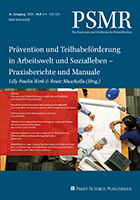Psychological Test and Assessment Modeling, Volume 52, 2010 (1)
Klaus D. Kubinger
Editorial: Psychological Test and Assessment Modeling![]() PDF of the full article
PDF of the full article
Matthias von Davier
Hierarchical mixtures of diagnostic models
Abstract | ![]() PDF of the full article
PDF of the full article
Günter Krampen
Direct measurement of psychotherapeutic outcomes: Experimental construction and validation of a brief scale
Abstract | ![]() PDF of the full article
PDF of the full article
Special topic:
Dispositions towards ridicule and being laughed at: Current research on gelotophobia, gelotophilia, and katagelasticism
René T. Proyer & Willibald Ruch
Editorial: Dispositions towards ridicule and being laughed at: Current re-search on gelotophobia, gelotophilia, and katagelasticism![]() PDF of the full article
PDF of the full article
Martin Führ
The applicability of the GELOPH15> in children and adolescents: First evaluation in a large sample of Danish pupils
Abstract | ![]() PDF of the full article
PDF of the full article
Willibald Ruch, René T. Proyer & Larry Ventis
The relationship of teasing in childhood to the expression of gelotophobia in adults
Abstract | ![]() PDF of the full article
PDF of the full article
Kim R. Edwards, Rod A. Martin & David J. A. Dozois
The fear of being laughed at, social anxiety, and memories of being teased during childhood
Abstract | ![]() PDF of the full article
PDF of the full article
Hugo Carretero-Dios, Willibald Ruch, Diana Agudelo, Tracey Platt & René T. Proyer
Fear of being laughed at and social anxiety: A preliminary psychometric study
Abstract | ![]() PDF of the full article
PDF of the full article
Hierarchical mixtures of diagnostic models
Matthias von Davier
Abstract
Psychological testing aims at making inferences about individual differences or the estimation of distributions of psychological constructs in groups of interest. However, a test instruments relationship to the construct, the actual variable of interest, may change across subpopulations, or the instruments measurement accuracy is not the same across subpopulations.
This paper introduces an extension of the mixture distribution general diagnostic model (GDM) that allows studying the population dependency of multidimensional latent trait models across observed and latent populations. Note that so-called diagnostic models do not aim at diagnosing individual test takers in the sense of a clinical diagnosis, or an extended case-based examination using multiple test instruments. The term cognitive diagnosis was coined following the development of models that attempt to identify (diagnose?) more than a single skill dimension. The GDM is a general modeling framework for confirmatory multidimensional item response models and includes well-known models such as item response theory (IRT), latent class analysis (LCA), and located latent class models as special cases. The hierarchical extensions of the GDM presented in this paper enable one to check the impact of clustered data, such as data from students with different native language background taking an English language test, on the structural parameter estimates of the GDM. Moreover, the hierarchical version of the GDM allows the examination of differences in skill distributions across these clusters.
Key words: Latent class analysis, hierarchical models, item response models, diagnostic models, logistic models
Matthias von Davier, PhD
Principal Research Scientist
Statistical and Psychometric Theory and Practice
ETS, MS 02-T
Princeton, NJ 08541, USA
E-Mail: mvondavier@ets.org
Direct measurement of psychotherapeutic outcomes: Experimental construction and validation of a brief scale
Günter Krampen
Abstract
Results of two studies on the construction of a brief questionnaire for the direct measurement of psychotherapeutic outcomes are presented. Test construction follows the theory of change in integrative, differential psychotherapy. Items focus on changes in behavior and experience with reference to increases in self-efficacy and improved coping in patients. Study 1 included 150 outpatients of 14 psychotherapists. Controlling for diagnosis, gender, and age, patients were randomized to a therapy group (n = 75) or a waiting-list control group (n = 75). After three months of waiting or psychotherapy, all subjects completed the "Questionnaire of Personal Changes consisting of 12 temporal comparatively formulated items. Group comparisons indicate the change sensitivity of the items and the scale score for psychotherapeutic effects. Study 2 followed a naturalistic design including 275 psychotherapy outpatients who completed the questionnaire 14-20 weeks after start of therapy. Results confirm acceptable psychometric properties of the scale with reference to item parameters and reliability. Convergent validity of the scale score is empirically supported by significant correlations to clinically relevant indicators of psychotherapeutic outcomes from indirect measurements of change.
Key words: direct measurement of change, psychotherapeutic outcomes, treatment effectiveness evaluation, psychometrics, psychological assessment
Prof. Günter Krampen, PhD
University of Trier
Department of Psychology
54286 Trier, Germany
E-Mail: krampen@uni-trier.de
The applicability of the GELOPH<15> in children and adolescents: First evaluation in a large sample of Danish pupils
Martin Führ
Abstract
Gelotophobia is defined as the fear of being laughed at. This is the first empirical study on gelotophobia among children and adolescents (aged 11-16 years). Data was collected in Denmark (N = 1,322). The Danish version of the GELOPH<15> (Führ, Proyer & Ruch, 2009) was used and yielded good psychometric properties in terms of a high internal consistency of the items and the factorial structure (one-dimensional solution) was highly similar to data for the adult version. As in adults, higher bullying experiences were well predicted by the individual expression of the fear of being laughed at. While the actual number of absent days from school was widely unrelated to gelotophobia, those pupils who frequently think about not attending school but have a low number of actual absent days yielded the highest gelotophobia scores. This study shows that gelotophobia can be reliably measured with the standard form of the GELOPH<15>. The pupils did not report problems with understanding the items (though the eleven year olds needed help by teachers for filling in the items). This study allows planning and conducting follow-up studies (e.g., longitudinal design) with much younger populations as has so far been studied. The knowledge about the fear of being laughed at among children and adolescents is still very limited.
Key words: absenteeism, adolescents, children, gelotophobia, humor
Assoc.Prof. Martin Führ, PhD
University of Aalborg, Department 11
Department of Communication and Psychology
Kroghstræde 3, Room: 1-208
9220 Aalborg, Denmark
E-Mail: humorforskning@webspeed.dk
The relationship of teasing in childhood to the expression of gelotophobia in adults
Willibald Ruch, René T. Proyer & Larry Ventis
Abstract
In observations from clinical practice, the origin of gelotophobia, the fear of being laughed at, was traced back to traumatizing experiences of being laughed at in childhood. Because gelotophobia is assumed to be mediated by a personal sense of shame, this hypothesis was tested using a group of gelotophobes (N = 99), a shame-based clinical group (N = 103), a non shame-based clinical group (N = 166), and normal controls (N = 495). While gelotophobes and the shame-based group reported having had more traumatizing experiences than the normal controls and the non shame-based group, their intensity and frequency did not explain individual differences in the fear of being laughed at for gelotophobes and the shame-based group.
Key words: gelotophobia, fear, laughter, shame, childhood
Prof. Willibald Ruch, PhD
Section on Personality and Assessment
Department of Psychology
University of Zurich
Binzmühlestrasse 14/7
8050 Zurich, Switzerland
E-Mail: w.ruch@psychologie.uzh.ch
The fear of being laughed at, social anxiety, and memories of being teased during childhood
Kim R. Edwards, Rod A. Martin & David J. A. Dozois
Abstract
Using a sample of 207 undergraduate students, we investigated: (1) relations between gelotophobia and memories of being the target of teasing during childhood and adolescence; and (2) associations between gelotophobia and social and specific fears and anxieties. Regression analyses revealed that higher gelotophobia scores were associated with a greater history of being teased about social behavior and academic excellence, but not about family background, appearance, or performance. Overall, gelotophobia was related to distress but not frequency of childhood teasing. Additional regression analyses revealed that gelotophobia was strongly related to three measures of social anxiety, but not to specific fears relating to death/illness/injury, animals, or situations. However, significant associations between gelotophobia and a history of being teased remained even after controlling for social anxiety. These results support Titzes (2009) view of gelotophobia as a syndrome that is related to, but distinct from, social phobia, which develops in part from repeated experiences of being the target of teasing and ridicule relating particularly to anxiety-based social skills deficits and interpersonal awkwardness.
Key words: gelotophobia, social skills, social phobia, anxiety, teasing
Kim Edwards, PhD
University of Western Ontario
Department of Psychology
Westminster Hall, London
Ontario, Canada N6A 3K7, Canada
E-Mail: kedward7@uwo.ca
Fear of being laughed at and social anxiety: A preliminary psychometric study
Hugo Carretero-Dios, Willibald Ruch, Diana Agudelo, Tracey Platt & René T. Proyer
Abstract
The present study examines the relationship between questionnaire measures of social phobia and gelotophobia. A sample of 211 Colombian adults filled in Spanish versions of the Social Anxiety and Distress scale (SAD; Watson & Friend, 1969), the Fear of Negative Evaluation scale (FNE; Watson & Friend, 1969) and the GELOPH<15> (Ruch & Proyer, 2008). Results confirmed that both Social Anxiety and Distress and Fear of Negative Evaluation scale overlapped with the fear of being laughed at without being identical with it. The SAD and FNE correlated highly with the GELOPH<15> but not all high scorers in these scales expressed a fear of being laughed at. Furthermore, an item factor analysis yielded three factors that were mostly loaded by items of the respective scales. This three-factor structure was verified using confirmatory factor analysis. A measure model where one general factor of social anxiety was specified, or another one where two different factors were defined (gelotophobia vs. social anxiety assessed by SAD and FNE) showed a very poor fit to the data. It is concluded that the fear of being laughed cannot fully be accounted for by these measures of social phobia.
Key words: fear of negative evaluation, gelotophobia, questionnaire, ridicule, social anxiety
Hugo Carretero Dios, PhD
Facultad de Psicología
Universidad de Granada
Campus Cartuja s/n
18071 Granada, España
E-Mail: hugocd@ugr.es























